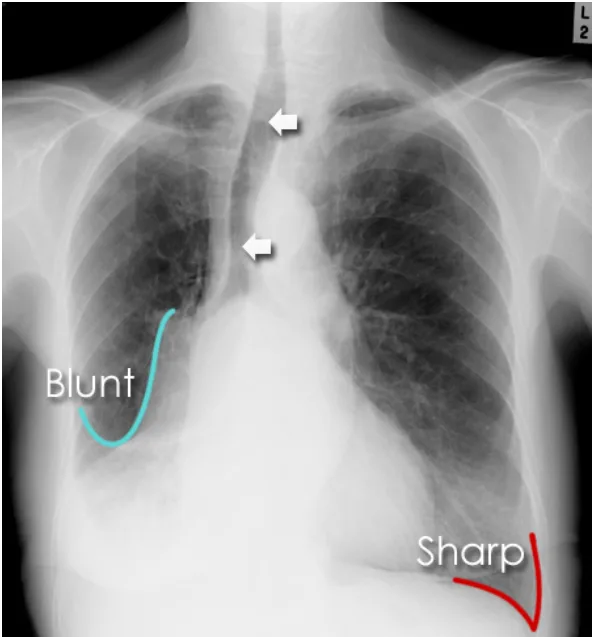What Is a Blunted Costophrenic Angle?
Have you ever heard your doctor mention a "blunted costophrenic angle" or "blunting of the left costophrenic angle" after looking at your chest X-ray? It might sound complicated, but it’s an important clue doctors use to understand what’s happening inside your chest. This article will explain what a blunted costophrenic angle is, why it happens, and what it means for your health.
What Is the Costophrenic Angle?
The costophrenic angle is where your diaphragm meets your ribs at the bottom of your chest. On a normal chest X-ray, this angle looks sharp and clear. It’s a key area doctors check to see if your lungs and pleural space (the area around your lungs) are healthy.
How It Looks on an X-ray
On a regular chest X-ray, the costophrenic angles are sharp and pointed. The right angle is usually a bit higher than the left because of the liver underneath it. When these angles are clear and sharp, it usually means there’s no extra fluid or problem in the pleural space.

What Does "Blunted" Mean?
When doctors say the costophrenic angle is "blunted," they mean it looks less sharp and more rounded on the X-ray. This usually indicates that something is filling up the space, often fluid, which needs further investigation. Blunting of the left costophrenic angle specifically refers to this finding on the left side.
Causes of a Blunted Costophrenic Angle
There are several reasons why the costophrenic angle might look blunted. Here are the main ones:
Pleural Effusion
Pleural effusion is the most common cause. It means there’s extra fluid in the pleural space. This fluid can be due to various reasons, like:
- Heart Failure: When the heart isn’t pumping blood effectively, fluid can build up in the lungs.
- Infections: Conditions like pneumonia can cause fluid to accumulate.
- Cancer: Tumors can cause fluid buildup.
- Blood (Hemothorax): Injury or surgery can lead to blood in the pleural space.
- Pus (Empyema): Infections can cause pus to fill the pleural space.
- Lymphatic Fluid (Chylothorax): A rare condition where lymphatic fluid builds up.
Atelectasis
Atelectasis means part of the lung has collapsed. When this happens, the lung tissue shrinks and may pull fluid into the costophrenic angle, making it look blunted.
Fibrosis
Fibrosis is scarring of the lung or pleural tissue. This can happen due to chronic inflammation or injury, leading to a blunted costophrenic angle. Conditions like tuberculosis or exposure to asbestos can cause fibrosis.
Other Causes
There are other, less common reasons for a blunted costophrenic angle, such as:
- Pleural Tumors: Tumors in the pleura can change the shape of the costophrenic angle.
- Diaphragm Problems: Issues with the diaphragm, like paralysis, can alter the angle.
- Chronic Lung Diseases: Severe chronic obstructive pulmonary disease (COPD) can change chest anatomy.
What Does It Mean for You?
A blunted costophrenic angle is a sign that something is going on in your chest. It’s not a diagnosis by itself but an indication that further tests are needed to find out what’s causing it.
How Doctors Investigate
Here’s how doctors figure out what’s causing the blunted angle:
- Medical History and Physical Exam: The doctor will ask about your symptoms and medical history and perform a physical exam.
- Chest X-ray Review: They’ll look closely at your chest X-ray for other signs, like lung opacities or heart enlargement.
- Further Imaging: Additional tests like ultrasound or CT scans may be done to get a better look.
- Thoracentesis: If there’s fluid, a needle might be used to take a sample for analysis.
- Other Tests: Blood tests, sputum analysis, or a biopsy might be needed to pinpoint the cause.
Treatment Options
Treatment depends on what’s causing the blunted costophrenic angle:
- For Pleural Effusion: Treating the underlying cause is crucial. This might involve diuretics for heart failure, antibiotics for infections, or chemotherapy for cancer. Large effusions may need to be drained.
- For Atelectasis: The goal is to re-expand the lung. This might involve breathing exercises, physiotherapy, or bronchoscopy to clear obstructions.
- For Fibrosis: Managing the condition involves medications to reduce inflammation or prevent further scarring, and sometimes surgery.
- For Other Causes: Specific treatments are tailored to the condition, like surgery for tumors or special therapies for diaphragm issues.
Real-life Examples
Case 1: Heart Failure
A 65-year-old man with heart failure has trouble breathing. His chest X-ray shows blunted costophrenic angles. Further tests confirm fluid buildup due to heart failure. Diuretics help remove the excess fluid, improving his symptoms and clearing the blunted angles on follow-up X-rays.
Case 2: Cancer
A 55-year-old woman with breast cancer experiences shortness of breath. Her chest X-ray shows a blunted right costophrenic angle. A CT scan and thoracentesis reveal the fluid is due to metastatic breast cancer. She receives chemotherapy, and the fluid is managed with pleurodesis to prevent recurrence.
Case 3: Infection
A 40-year-old man with pneumonia has a persistent fever and chest pain. His chest X-ray shows a blunted left costophrenic angle. An ultrasound confirms a complicated pleural effusion. Thoracentesis reveals pus, and he is treated with antibiotics and drainage, resolving the infection and effusion.
Before You Go...
Curious about what a blunted costophrenic angle means for your health?
X-ray Interpreter can help demystify your chest X-ray results. Our advanced AI tool offers clear, detailed explanations of findings like blunted costophrenic angles, empowering you to make informed health decisions.
Upload your image now to try it for free.